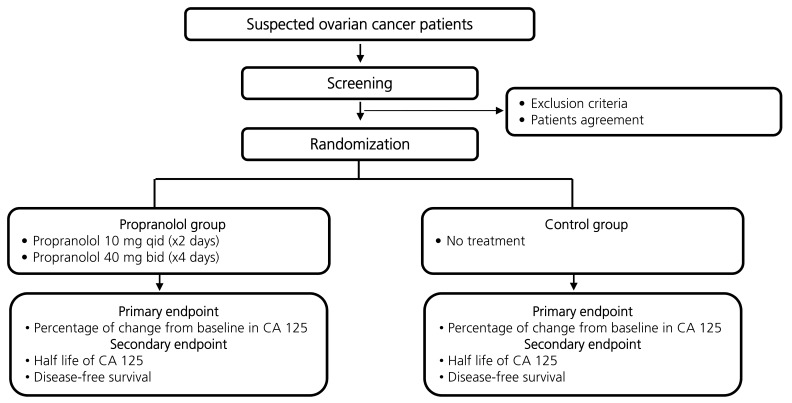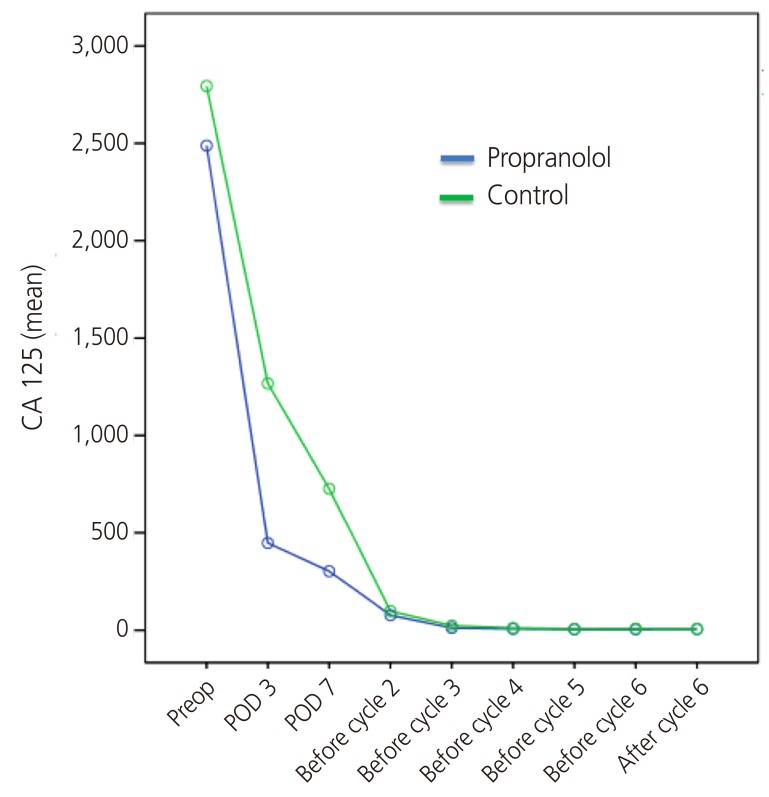Obstet Gynecol Sci.
2017 Mar;60(2):170-177. 10.5468/ogs.2017.60.2.170.
Perioperative administration of propranolol to women undergoing ovarian cancer surgery: A pilot study
- Affiliations
-
- 1Department of Obstetrics and Gynecology, Samsung Medical Center, Sungkyunkwan University School of Medicine, Seoul, Korea. huna0@naver.com
- KMID: 2372801
- DOI: http://doi.org/10.5468/ogs.2017.60.2.170
Abstract
OBJECTIVE
This study was done to evaluate whether perioperative propranolol (ß-blocker) in ovarian cancer patients undergoing debulking surgery reduced perioperative tumor growth induced by surgical stress.
METHODS
This was a prospective randomized single institution analysis. The primary objective was to compare the changes in CA 125 level (changes between preoperation day 2 and postoperative day 7). As a study arm, patients received a low dose of propranolol 40 mg/day (4×10 mg) starting two days before surgery and 40 mg twice daily for three days following surgery.
RESULTS
Twenty-two patients were enrolled and 16 were evaluable for efficacy. The drug was well tolerated. The mean decrease of CA 125 during the seven perioperative days was 83.1±8.9% in the propranolol group and 72.4±14.7% in the placebo group. The difference was statistically significant (P=0.044). The change of C-reactive protein, cortisol, and anxiety score (State-Trait Anxiety Inventory-X1) were not different between the two groups.
CONCLUSION
This preliminary result is the first to directly test the role of perioperative propranolol on tumor growth. Even with the small sample size and short term use of the drug, perioperative propranolol was effective in reducing tumor burden (as measured by CA 125) suggesting its potential benefits in decreasing perioperative tumor growth.
Keyword
MeSH Terms
Figure
Cited by 2 articles
-
Impact of beta blockers on survival outcomes in ovarian cancer: a nationwide population-based cohort study
Min-Hyun Baek, Dae-Yeon Kim, Seon Ok Kim, Ye-Jee Kim, Young-Han Park
J Gynecol Oncol. 2018;29(6):. doi: 10.3802/jgo.2018.29.e82.Impact of Angiotensin Receptor Blockers, Beta Blockers, Calcium Channel Blockers and Thiazide Diuretics on Survival of Ovarian Cancer Patients
Min Ae Cho, Soo Young Jeong, Insuk Sohn, Myeong-Seon Kim, Jun Hyeok Kang, E Sun Paik, Yoo-Young Lee, Chel Hun Choi
Cancer Res Treat. 2020;52(2):645-654. doi: 10.4143/crt.2019.509.
Reference
-
1. Peeters CF, de Waal RM, Wobbes T, Westphal JR, Ruers TJ. Outgrowth of human liver metastases after resection of the primary colorectal tumor: a shift in the balance between apoptosis and proliferation. Int J Cancer. 2006; 119:1249–1253. PMID: 16642475.
Article2. Wildbrett P, Oh A, Carter JJ, Schuster H, Bessler M, Jaboci CA, et al. Increased rates of pulmonary metastases following sham laparotomy compared to CO2 pneumoperitoneum and the inhibition of metastases utilizing perioperative immunomodulation and a tumor vaccine. Surg Endosc. 2002; 16:1162–1169. PMID: 11984655.
Article3. Lee SW, Gleason N, Blanco I, Asi ZK, Whelan RL. Higher colon cancer tumor proliferative index and lower tumor cell death rate in mice undergoing laparotomy versus insufflation. Surg Endosc. 2002; 16:36–39. PMID: 11961601.
Article4. Eschwege P, Dumas F, Blanchet P, Le Maire V, Benoit G, Jardin A, et al. Haematogenous dissemination of prostatic epithelial cells during radical prostatectomy. Lancet. 1995; 346:1528–1530. PMID: 7491049.5. Yamaguchi K, Takagi Y, Aoki S, Futamura M, Saji S. Significant detection of circulating cancer cells in the blood by reverse transcriptase-polymerase chain reaction during colorectal cancer resection. Ann Surg. 2000; 232:58–65. PMID: 10862196.
Article6. Zetter BR. Angiogenesis and tumor metastasis. Annu Rev Med. 1998; 49:407–424. PMID: 9509272.
Article7. Hofer SO, Molema G, Hermens RA, Wanebo HJ, Reichner JS, Hoekstra HJ. The effect of surgical wounding on tumour development. Eur J Surg Oncol. 1999; 25:231–243. PMID: 10336800.
Article8. Sietses C, Beelen RH, Meijer S, Cuesta MA. Immunological consequences of laparoscopic surgery, speculations on the cause and clinical implications. Langenbecks Arch Surg. 1999; 384:250–258. PMID: 10437613.
Article9. Sood AK, Bhatty R, Kamat AA, Landen CN, Han L, Thaker PH, et al. Stress hormone-mediated invasion of ovarian cancer cells. Clin Cancer Res. 2006; 12:369–375. PMID: 16428474.
Article10. Melhem-Bertrandt A, Chavez-Macgregor M, Lei X, Brown EN, Lee RT, Meric-Bernstam F, et al. Beta-blocker use is associated with improved relapse-free survival in patients with triple-negative breast cancer. J Clin Oncol. 2011; 29:2645–2652. PMID: 21632501.
Article11. Lemeshow S, Sorensen HT, Phillips G, Yang EV, Antonsen S, Riis AH, et al. β-Blockers and survival among Danish patients with malignant melanoma: a population-based cohort study. Cancer Epidemiol Biomarkers Prev. 2011; 20:2273–2279. PMID: 21933972.
Article12. Lee JW, Shahzad MM, Lin YG, Armaiz-Pena G, Mangala LS, Han HD, et al. Surgical stress promotes tumor growth in ovarian carcinoma. Clin Cancer Res. 2009; 15:2695–2702. PMID: 19351748.
Article13. Kumar P, Rehani MM, Kumar L, Sharma R, Bhatla N, Chaudhry R, et al. Tumor marker CA-125 as an evaluator and response indicator in ovarian cancer: its quantitative correlation with tumor volume. Med Sci Monit. 2005; 11:CR84–CR89. PMID: 15668638.14. Abramovitch R, Marikovsky M, Meir G, Neeman M. Stimulation of tumour growth by wound-derived growth factors. Br J Cancer. 1999; 79:1392–1398. PMID: 10188881.
Article15. O'Reilly MS, Boehm T, Shing Y, Fukai N, Vasios G, Lane WS, et al. Endostatin: an endogenous inhibitor of angiogenesis and tumor growth. Cell. 1997; 88:277–285. PMID: 9008168.16. Mathew B, Lennon FE, Siegler J, Mirzapoiazova T, Mambetsariev N, Sammani S, et al. The novel role of the mu opioid receptor in lung cancer progression: a laboratory investigation. Anesth Analg. 2011; 112:558–567. PMID: 21156980.17. Bernabe DG, Tamae AC, Biasoli ER, Oliveira SH. Stress hormones increase cell proliferation and regulates interleukin-6 secretion in human oral squamous cell carcinoma cells. Brain Behav Immun. 2011; 25:574–583. PMID: 21187140.18. Kerros C, Brood I, Sola B, Jauzac P, Allouche S. Reduction of cell proliferation and potentiation of Fas-induced apoptosis by the selective kappa-opioid receptor agonist U50 488 in the multiple myeloma LP-1 cells. J Neuroimmunol. 2010; 220:69–78. PMID: 20163878.
Article19. Roche-Nagle G, Connolly EM, Eng M, Bouchier-Hayes DJ, Harmey JH. Antimetastatic activity of a cyclooxygenase-2 inhibitor. Br J Cancer. 2004; 91:359–365. PMID: 15213717.
Article20. Sood AK, Armaiz-Pena GN, Halder J, Nick AM, Stone RL, Hu W, et al. Adrenergic modulation of focal adhesion kinase protects human ovarian cancer cells from anoikis. J Clin Invest. 2010; 120:1515–1523. PMID: 20389021.
Article21. Thaker PH, Han LY, Kamat AA, Arevalo JM, Takahashi R, Lu C, et al. Chronic stress promotes tumor growth and angiogenesis in a mouse model of ovarian carcinoma. Nat Med. 2006; 12:939–944. PMID: 16862152.
Article22. Wei D, Wang L, He Y, Xiong HQ, Abbruzzese JL, Xie K. Celecoxib inhibits vascular endothelial growth factor expression in and reduces angiogenesis and metastasis of human pancreatic cancer via suppression of Sp1 transcription factor activity. Cancer Res. 2004; 64:2030–2038. PMID: 15026340.
Article23. Yang EV, Kim SJ, Donovan EL, Chen M, Gross AC, Webster Marketon JI, et al. Norepinephrine upregulates VEGF, IL-8, and IL-6 expression in human melanoma tumor cell lines: implications for stress-related enhancement of tumor progression. Brain Behav Immun. 2009; 23:267–275. PMID: 18996182.
Article24. Degoute CS. Controlled hypotension: a guide to drug choice. Drugs. 2007; 67:1053–1076. PMID: 17488147.25. Granville-Grossman KL, Turner P. The effect of propranolol on anxiety. Lancet. 1966; 1:788–790. PMID: 4159809.26. Tyrer PJ, Lader MH. Effects of beta adrenergic blockade with sotalol in chronic anxiety. Clin Pharmacol Ther. 1973; 14:418–426. PMID: 4572800.
Article27. Elman MJ, Sugar J, Fiscella R, Deutsch TA, Noth J, Nyberg M, et al. The effect of propranolol versus placebo on resident surgical performance. Trans Am Ophthalmol Soc. 1998; 96:283–291. PMID: 10360293.28. Riedinger JM, Eche N, Basuyau JP, Dalifard I, Hacene K, Pichon MF. Prognostic value of serum CA 125 bi-exponential decrease during first line paclitaxel/platinum chemotherapy: a French multicentric study. Gynecol Oncol. 2008; 109:194–198. PMID: 18329083.
Article29. Osman N, O'Leary N, Mulcahy E, Barrett N, Wallis F, Hickey K, et al. Correlation of serum CA125 with stage, grade and survival of patients with epithelial ovarian cancer at a single centre. Ir Med J. 2008; 101:245–247. PMID: 18990955.
- Full Text Links
- Actions
-
Cited
- CITED
-
- Close
- Share
- Similar articles
-
- The Effect of Atropine and Isoproterenol an the Heart Rate and the Blood Pressure after Propranolol during Halothane Anesthesia
- Propranolol use in a psychiatric in-patients unit(I)
- The Effect of Propranolol on the Blood Pressure and Pulse Rate during Ether Anesthesia
- Controlled ovarian hyperstimulation for fertility preservation in women with breast cancer: Practical issues
- New paradigm of intraperitoneal chemotherapy in ovarian carcinoma




